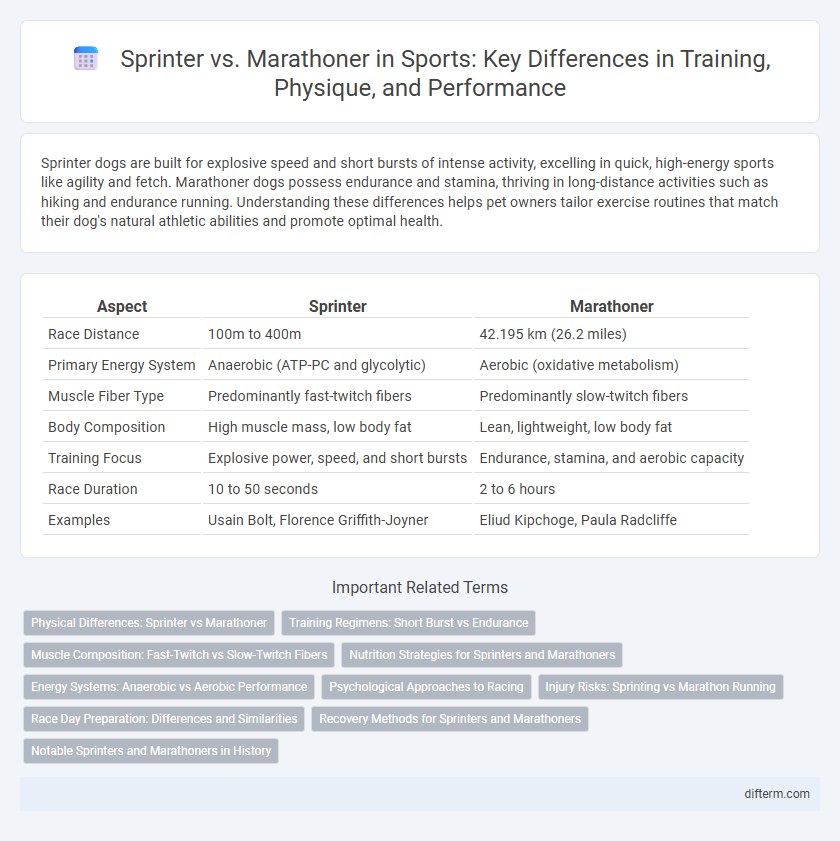Sprinter dogs are built for explosive speed and short bursts of intense activity, excelling in quick, high-energy sports like agility and fetch. Marathoner dogs possess endurance and stamina, thriving in long-distance activities such as hiking and endurance running. Understanding these differences helps pet owners tailor exercise routines that match their dog's natural athletic abilities and promote optimal health.
Table of Comparison
| Aspect | Sprinter | Marathoner |
|---|---|---|
| Race Distance | 100m to 400m | 42.195 km (26.2 miles) |
| Primary Energy System | Anaerobic (ATP-PC and glycolytic) | Aerobic (oxidative metabolism) |
| Muscle Fiber Type | Predominantly fast-twitch fibers | Predominantly slow-twitch fibers |
| Body Composition | High muscle mass, low body fat | Lean, lightweight, low body fat |
| Training Focus | Explosive power, speed, and short bursts | Endurance, stamina, and aerobic capacity |
| Race Duration | 10 to 50 seconds | 2 to 6 hours |
| Examples | Usain Bolt, Florence Griffith-Joyner | Eliud Kipchoge, Paula Radcliffe |
Physical Differences: Sprinter vs Marathoner
Sprinters possess a higher proportion of fast-twitch muscle fibers, enabling explosive power and rapid acceleration, while marathoners develop slow-twitch fibers optimized for endurance and energy efficiency over long distances. Sprinters typically have a more muscular, compact build to maximize speed and force, whereas marathoners exhibit a leaner physique to reduce energy expenditure and improve heat dissipation. These distinct physical adaptations reflect the contrasting demands of anaerobic sprinting and aerobic marathon running.
Training Regimens: Short Burst vs Endurance
Sprinters emphasize explosive power training with high-intensity interval workouts and resistance exercises to enhance speed and muscle strength. Marathoners prioritize long-distance endurance runs and aerobic conditioning to build stamina and cardiovascular efficiency over extended periods. These distinct training regimens reflect the unique physiological demands of short bursts of maximum effort versus sustained energy output.
Muscle Composition: Fast-Twitch vs Slow-Twitch Fibers
Sprinters predominantly possess a higher proportion of fast-twitch muscle fibers, enabling explosive power and rapid acceleration over short distances. In contrast, marathoners rely on slow-twitch muscle fibers, which provide endurance and efficient oxygen utilization for prolonged aerobic activity. This fundamental difference in muscle composition dictates the distinct training regimens and performance capabilities between sprinters and marathoners.
Nutrition Strategies for Sprinters and Marathoners
Sprinters require high-intensity energy sources, emphasizing carbohydrate loading and quick-digesting proteins to fuel short bursts of explosive power and aid muscle recovery. Marathoners focus on sustained energy through complex carbohydrates, balanced with electrolytes and hydration strategies to maintain endurance and prevent fatigue over long distances. Both athletes prioritize nutrient timing, with sprinters consuming protein and carbs immediately post-training, while marathoners implement carbohydrate-rich meals and hydration before, during, and after races for optimal performance.
Energy Systems: Anaerobic vs Aerobic Performance
Sprinters rely heavily on the anaerobic energy system, utilizing stored ATP and phosphocreatine for short, explosive bursts of speed lasting up to 10 seconds, followed by anaerobic glycolysis for events up to 60 seconds. Marathoners depend predominantly on the aerobic energy system, efficiently oxidizing carbohydrates and fats over prolonged periods to sustain endurance performance across distances over 42 kilometers. The contrast between anaerobic and aerobic pathways highlights the metabolic demands shaping training protocols and physiological adaptations for sprinting versus marathon running.
Psychological Approaches to Racing
Sprinters rely heavily on intense mental focus and visualization techniques to optimize burst performance during short, high-pressure races. Marathoners develop resilience and pacing strategies, using mindfulness and mental endurance to maintain steady motivation across long distances. Both athletes benefit from cognitive rehearsal, but their psychological approaches differ significantly due to the distinct physical and mental demands of sprinting versus marathon running.
Injury Risks: Sprinting vs Marathon Running
Sprinters face a higher risk of acute injuries such as hamstring strains and muscle tears due to explosive force and rapid acceleration demands. Marathon runners, in contrast, are more susceptible to overuse injuries like stress fractures, shin splints, and tendonitis caused by repetitive, long-distance impact. Both disciplines require distinct conditioning and recovery strategies to mitigate their specific injury risks effectively.
Race Day Preparation: Differences and Similarities
Sprinters focus on explosive warm-ups and short, intense stretches to maximize muscle activation and speed, while marathoners prioritize endurance and energy conservation through dynamic stretching and light jogging. Both athletes emphasize proper nutrition and hydration tailored to their event length, ensuring optimal energy levels and muscle performance during race day. Mental preparation involving focus and visualization is crucial for both to achieve peak performance under competitive stress.
Recovery Methods for Sprinters and Marathoners
Sprinters often rely on active recovery techniques such as dynamic stretching, foam rolling, and short-duration ice baths to reduce muscle stiffness and accelerate lactic acid clearance. Marathoners prioritize nutrient-rich hydration, electrolyte replenishment, and prolonged rest periods combined with low-intensity cross-training to repair muscle fibers and restore glycogen stores. Both athletes benefit from tailored recovery protocols that match the intensity and duration of their respective training demands.
Notable Sprinters and Marathoners in History
Notable sprinters like Usain Bolt shattered world records in the 100m and 200m, showcasing explosive speed and power. Legendary marathoners such as Eliud Kipchoge redefined endurance running with historic performances, including the first marathon completed under two hours in an unofficial event. Both athletes exemplify peak physical prowess within their respective disciplines.
sprinter vs marathoner Infographic

 difterm.com
difterm.com